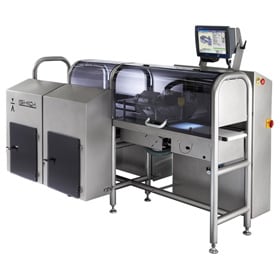Smaller companies may have lower levels of automation and changeovers as more changes can mean there is more chance of things going wrong.
Torsten Giese, marketing manager public relations and exhibitions, told FoodQualityNews.com that quality control was needed to ensure consumer and brand protection.
He said it protects firms from things such as under and overweight claims and incorrectly labelled packs.
“You are packing fresh salmon pieces for Marks & Spencer for example and the sell by says 2013, disaster strikes as all the packs must be returned, you have to pay for the return, the loss of product and M&S may fine you. So you have lost your credibility in the marketplace and money in terms of production.
“Even if the contamination is just in one pack, the supermarkets are nervous and will take all of the packs off the shelves. It might have been due to a fault inside the machine if there is some metal loose and it broke off into one of the packs.”
Under and overweight is legally critical but not consumer critical, he said.
“The consumer might not notice that the pack is not the right weight, they are unlikely to weigh it, but it is important not to pack five grams less per pack.”
Speed of automation
Automation can speed up processes such as barcode reading, looking at use by and label positions from 60 to 120 packs per minute.

Ishida offers a seal tester that looks at the top seal and thermoformed film or rigid trays and has an integrated vision system and the Checkweigher is useful for fish that are different weights and are priced by kilo.
“If you can weigh the product accurately you can do more fixed weight which allows you to sell at a fixed price. If the product is priced £1.57 and the other at £1.45 you are more likely to pick up the one priced at £1.45.”
The rejection software on the reject failsafe system satisfies companies such as M&S and Tesco who require pack tracing to know where product is at all times.
“Other supermarkets will follow and they are quite right to do this. We need to know where the pack is in the quality control system at all times so we know what is happening. If a product has metal in it, it is put in the reject bin which is locked and can only be opened by certain people.”
Packaging weight
Sensors sense the packaging on weight, if it is wrong it will end up on the reject belt and in the bin. If and when it is full, the machine will say the reject bin is full and production must be stopped until it is emptied.
The software measures efficiency on the production line, what is the line efficiency, what is happening at what speed, what stage of the shift are we at so it can measure downtime and find out what is happening in gaps in the production, said Giese.
Ishida Data Capture System (IDCS) is an underutilised resource for checkweighers, he said.
It can introduce a paper-less environment and more visibility about how good you actually are.
This can be done by generating efficiency statistics on availability, performance and quality in percentage form and having the software to show checkweigher efficiency by packs going across it.
“For quality there should be 7,000 packs but how many are there that are in the final packing stage and for performance you are doing seven and a half hours at what speed? 100 packs per minute, but the line speed is at 92 packs per minute on average, so you have a problem.
“But is it with your tray sealer or is your thermoformer slow and maybe you have downtime for five minutes when nothing happened, you can find out why.”
Pack speed
Giese said the seal tester is used mostly for snacks to look at the top seal or thermoformed trays.
“If you do this by hand maybe you can do 40 packs per minute, by 60 or 70 packs per minute you would struggle. The machine can detect 2mm-1mm seal breaches that are big enough to have an impact at 120 trays a minute.
“For smaller breaches it can do about 50 packs per minute as it needs the time to detect leaks that can affect the product.”
He said the vision camera can be on top or below the product to look at the photos or label on packs, to see if the pack labelled, is the barcode readable, is the sell by date right to ensure you have traceability.
“If you 1,000 packs of mince meat for Aldi and you make a mistake and you are packing labels that say Lidl, then you are packing for the wrong company and need to stop production,” said Giese.
“It can look at the position of the label on the pack as some retailers want it in a particular place, check sell by and show on the display what we are looking for.”
